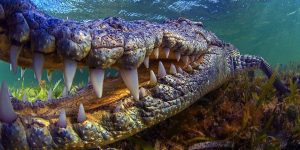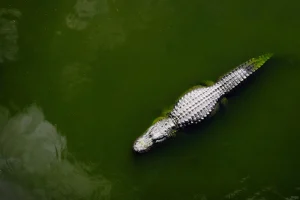The 5 Largest Crocodiles Ever Recorded
The 5 largest crocodiles ever recorded in history are truly astonishing specimens, showcasing the immense size and power these reptilian creatures can attain. The title of the largest crocodile ever goes to “Lolong,” a saltwater crocodile captured in the Philippines in 2011. Lolong measured a staggering 6.17 meters, or over 20 feet in length, and weighed 1,075 kg, making him a formidable beast. Following closely behind is “Cassius,” another saltwater crocodile from Australia who measures about 5.48 meters long. “Utah,” a Nile crocodile from Uganda, is reported to be around 5.5 meters in length.
Another colossal crocodile is “Gustave,” a Nile crocodile from Burundi, notorious for his size and alleged aggression. Gustave is believed to be over 6 meters long, but due to difficulties in capturing him, his size isn’t officially confirmed. Lastly, there’s “Krys,” nicknamed after the woman who captured him in Australia. Krys was a saltwater crocodile measuring an estimated 8.63 meters, but this measurement is also unverified. These five crocodiles, recognized for their extraordinary size, are awe-inspiring examples of the extremes found within the world’s wildlife.

The 3 Largest Extinct Crocodylians
The crocodylian family, which includes present-day crocodiles, alligators, caimans, and gharials, has a rich and diverse evolutionary history dating back more than 200 million years. Among its extinct members, three species stand out due to their enormous size. The first, Sarcosuchus imperator, popularly known as the “SuperCroc,” lived approximately 110 million years ago in the region now known as the Sahara Desert. Measuring up to 40 feet in length and weighing up to 8 tons, it was double the size of the largest modern crocodile. The second, Purussaurus brasiliensis, was native to South America and existed 8 million years ago. It was known for its powerful jaw strength and could grow up to 42 feet long.
The last of the three, Rhamphosuchus crassidens, inhabited what is now India around 10 million years ago. Although it was slightly smaller than the other two, it was still an impressive 36 feet long. These extinct crocodylians were apex predators in their respective environments, their massive size enabling them to tackle even the largest prey. Their extinction can be attributed to changing environments and climate shifts, which would have significantly affected their food sources and habitats. While they may no longer roam the earth, these giant crocodylians are a testament to the diversity and adaptability of this remarkable group of reptiles.
The 4 Largest Living Crocodiles
The four largest living crocodiles are awe-inspiring creatures that command respect due to their sheer size and power. First on the list is the Saltwater Crocodile, also known as “Salties,” which is the largest living reptile and predator in the world. These colossal creatures can reach a staggering length of up to 7 meters and weigh as much as 2,000 kilograms. They inhabit the mangrove swamps, deltas, lagoons, and lower stretches of rivers in parts of the eastern Indian and South Pacific Oceans.
The second largest is the Nile Crocodile, inhabiting the aquatic regions of Sub-Saharan Africa. They can grow up to 6 meters long and weigh approximately 1,090 kilograms. Renowned for their aggressive nature, Nile Crocodiles, like their Saltwater counterparts, are also apex predators and are responsible for numerous human fatalities each year.
Next is the Orinoco Crocodile, a critically endangered species found in the Orinoco River’s freshwater environments in Colombia and Venezuela. They can measure up to 4.8 meters in length and weigh up to 380 kilograms. Despite their formidable size, they primarily feed on small mammals, birds, and fish.
Lastly, the Mugger Crocodile, also known as the Marsh Crocodile, is native to freshwater habitats from southern Iran to the Indian subcontinent. They typically grow to about 3.5 meters in length and weigh around 225 kilograms. Unlike some of its larger cousins, the Mugger is considered less dangerous to humans but is still a formidable predator.
From the brackish water of coastal regions to the freshwater of rivers and marshes, these four crocodile species represent some of the largest and most formidable predators on the planet. Yet, they are more than just their size and predatory prowess. They are key players in maintaining the balance in their respective ecosystems, serving as both predators and scavengers to keep populations of other species in check.

The Current Record-Holding Crocodile
The record for the largest crocodile ever captured is currently held by a colossal specimen named Lolong. This saltwater crocodile, native to the Philippines, was captured in 2011. Measuring an impressive 6.17 meters (or 20.24 feet) in length and weighing approximately 1075 kilograms (or 2370 pounds), Lolong’s size is truly exceptional. The crocodile was found in a creek following a two-year search after a series of mysterious disappearances and attacks on humans and livestock occurred in the vicinity. Lolong was named after a local crocodile hunter, Ernesto ‘Lolong’ Goloran Cañete, who died of a stroke just days before the crocodile was captured. The capturing process was an arduous and dangerous task that took around three weeks to complete and involved the combined efforts of the local government unit, the local residents, and a team of professional crocodile hunters.
Lolong was eventually caught and became an instant sensation, drawing international attention. His capture not only ensured the safety of the local residents but also raised awareness about the plight of crocodiles and their habitats. Despite his fearsome reputation, Lolong lived out the remainder of his days in captivity, showcasing his incredible size to the world. He was housed in a special enclosure in the Bunawan Eco-Park and Wildlife Reservation Center, where he received proper care and attention. Unfortunately, Lolong died in 2013, but his legacy lives on. He remains the current record-holding crocodile in the Guinness Book of World Records, a testament to the immense size that these ancient reptiles can reach.
Legendary Crocodiles: Famous Specimens and Their Stories
Legendary crocodiles represent a fascinating aspect of natural history, with various specimens gaining notoriety due to their size, behavior, or unique stories. One of the most famous crocodiles, nicknamed Gustave, is known to inhabit the waters of the Ruzizi River in Burundi. This beast, rumored to be over 18 feet long and weighing a ton, is renowned for his alleged toughness and longevity, surviving numerous attempts on his life. Gustave is believed to have been responsible for the demise of hundreds of people, earning him a fearsome reputation.
Another legendary specimen is Lolong, an Indo-Pacific saltwater crocodile from the Philippines. Lolong was recognized by the Guinness World Records as the largest crocodile in captivity, reaching an astounding length of 20.24 feet. This magnificent creature became a tourist attraction, showcasing the awe-inspiring power and size that crocodiles can attain.

In the Northern Territory of Australia, another famous crocodile, Sweetheart, made headlines. Unlike Gustave and Lolong, Sweetheart was known for his non-aggressive behavior towards humans. However, he had a proclivity for attacking outboard motors, causing concern among boaters. Upon his unfortunate death, Sweetheart was preserved and is now on display at the Museum and Art Gallery of the Northern Territory, serving as a testament to the grandeur of these ancient reptiles.
The stories of these legendary crocodiles, whether feared or admired, underscore the fascinating diversity within this species. These creatures, with their immense strength and resilience, command our respect and remind us of the incredible power of nature. Their tales, passed from generation to generation, continue to inspire awe and curiosity, contributing to the rich tapestry of natural history. Their legendary status serves as a reminder of the delicate balance between humans and wildlife, emphasizing the importance of preserving these majestic creatures and their habitats.
Conservation and Protection of Large Crocodiles
Conservation and protection of large crocodiles is an imperative issue that requires immediate attention. These formidable creatures play a critical role in maintaining balance in the ecosystems they inhabit. However, their survival is under immense threat due to various human activities such as habitat destruction and hunting for their skin and meat. As apex predators, they help regulate the population of other aquatic and terrestrial species, contributing to biodiversity. Their presence is also an indicator of healthy wetland environments. Therefore, it’s crucial to undertake conservation efforts to protect these ancient reptiles.
Educating local communities about the ecological value of large crocodiles and the repercussions of their decline can help foster a sense of responsibility and foster coexistence. Meanwhile, establishing protected areas and reserves can provide a safe haven for them to thrive without human interference. Monitoring their population and tracking their movement can also aid in conservation by providing valuable data to help guide management strategies. Furthermore, implementing sustainable crocodile farming for commercial purposes can help reduce the pressure on wild populations.
It’s also worth noting that protecting these reptiles doesn’t mean disregarding the safety of human communities. Implementing measures to mitigate human-crocodile conflicts, such as building barriers around inhabited areas and educating people about safety precautions, is equally important.
The plight of large crocodiles is a reminder of the broader crisis facing our planet’s biodiversity. It is our duty as stewards of nature to ensure their survival, not just for their sake, but for the health of our ecosystems and for future generations to appreciate. The conservation and protection of these magnificent creatures is not merely a matter of animal welfare, but a significant step towards preserving the intricate web of life on Earth.
